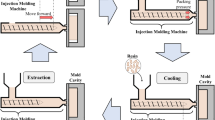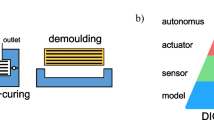Abstract
Injection molding is one of the most popular manufacturing methods for making complex plastic objects. Faster numerical simulation of this manufacturing process would allow faster and cheaper design cycles of new products. In this work, we propose a data processing pipeline that includes the extraction of data from Moldflow simulation projects and the prediction of the fill time and deflection distributions over 3-dimensional surfaces using machine learning models. We propose algorithms for the engineering of features, including information of injector gates parameters that will mostly affect the time for plastic to reach the particular point of the form for fill time prediction, and geometrical features for deflection prediction. We propose and evaluate machine learning models for fill time and deflection distribution prediction and provide values of Mean Absolute Error, Median Absolute Error, and Root Mean Square Error metrics. Finally, we measure the execution time of our solution and show that our solution is much faster than Moldflow: approximately, 17 times and 14 times faster for mean and median total times, respectively, comparing the times of all analysis stages for deflection prediction. Our solution has been implemented in a prototype web application that was approved by the management board of Fiat Chrysler Automobiles and Illogic SRL. As one of the promising applications of similar surrogate modeling approaches, we envision the use of trained models as a fast objective function for optimizing injection molding process parameters, such as optimal placement of gates, which could significantly aid engineers in this task, or even automate it.










Similar content being viewed by others
References
Belyaev M, Burnaev E, Kapushev Y (2014) Exact inference for gaussian process regression in case of big data with the cartesian product structure. arXiv:1403.6573
Bronstein MM, Bruna J, LeCun Y, Szlam A, Vandergheynst P (2017) Geometric deep learning: going beyond Euclidean data. IEEE Signal Process Mag 34(4):18–42. https://doi.org/10.1109/MSP.2017.2693418
Chen X, Chen X, Zhou W, Zhang J, Yao W (2020) The heat source layout optimization using deep learning surrogate modeling. Struct Multidiscip Optim 62(6):3127–3148
Cohen TS, Weiler M, Kicanaoglu B, Welling M (2019) Gauge Equivariant Convolutional Networks and the Icosahedral CNN. arXiv:1902.04615 [cs, stat]
Corno J, Georg N, Zadeh SG, Zadeh SG, Heller J, Gubarev V, Roggen T, Römer U, Schmidt C, Schöps S, Schultz J, Sulimov A, van Rienen U (2020) Uncertainty modeling and analysis of the european x-ray free electron laser cavities manufacturing process. Nucl Instr Methods Phys Res Sect A. https://doi.org/10.1016/j.nima.2020.164135
de Haan P, Weiler M, Cohen T, Welling M (2020) Gauge equivariant mesh CNNs: anisotropic convolutions on geometric graphs. arXiv:2003.05425 [cs, stat]
García V, Sánchez JS, Rodríguez-Picón LA, Méndez-González LC, de Jesús Ochoa-Domínguez H (2019) Using regression models for predicting the product quality in a tubing extrusion process. J Intell Manuf 30(6):2535–2544
Garcia-Garcia A, Gomez-Donoso F, Rodríguez J, Orts S, Cazorla M, Azorin-Lopez J (2016) PointNet: a 3D convolutional neural network for real-time object class recognition. pp 1578–1584. https://doi.org/10.1109/IJCNN.2016.7727386
Gong S, Chen L, Bronstein M, Zafeiriou S (2019) SpiralNet++: a fast and highly efficient mesh convolution operator
Han ZH, Zhang KS (2012) Surrogate-based optimization. In: Real-world applications of genetic algorithms. InTech, https://doi.org/10.5772/36125, www.intechopen.com
Injection A (2020) Hot runner mould injection manufacturers. www.anole-hot-runner.com/hot-runner-mould.htm
Jian Zhao GC (2016) An innovative surrogate-based searching method for reducing warpage and cycle time in injection molding. Adv Polym Technol. https://doi.org/10.1002/adv.21554
Liao XP, Ruan T, Xia W, Ma JY, Li LL (2011) Multi-objective optimization by gaussian genetic algorithm and its application in injection modeling. Adv Mater Res. https://doi.org/10.4028/www.scientific.net/amr.399-401.1672
Liu H, Ong YS, Shen X, Cai J (2020) When gaussian process meets big data: a review of scalable gps. IEEE Trans Neural Netw Learn Syst 31(11):4405–4423
Luo L, Yao Y, Gao F, Zhao C (2018) Mixed-effects gaussian process modeling approach with application in injection molding processes. J Process Control. https://doi.org/10.1016/j.jprocont.2017.12.003
Maturana D, Scherer S (2015) VoxNet: A 3D convolutional neural network for real-time object recognition. In: 2015 IEEE/RSJ international conference on intelligent robots and systems (IROS). IEEE, Hamburg, Germany, pp 922–928. https://doi.org/10.1109/IROS.2015.7353481
Morand L, Helm D, Iza-Teran R, Garcke J (2019) A knowledge-based surrogate modeling approach for cup drawing with limited data. null https://doi.org/10.1088/1757-899x/651/1/012047
Moseley B, Markham A, Nissen-Meyer T (2018) Fast approximate simulation of seismic waves with deep learning. arXiv:1807.06873 [physics]
Muhendislik (2020) Homepage of element muhendislik. https://www.elementmuhendislik.com/
Mukras SM, Omar HM, Mufadi FA (2019) Experimental-based multi-objective optimization of injection molding process parameters. Arab J Sci Eng 44(9):7653–7665
Orihara R, Narasaki R, Yoshinaga Y, Morioka Y, Kokojima Y (2018) Approximation of time-consuming simulation based on generative adversarial network. In: 2018 IEEE 42nd annual computer software and applications conference (COMPSAC), vol 02, pp 171–176. https://doi.org/10.1109/COMPSAC.2018.10223, iSSN: 0730-3157
Qi CR, Yi L, Su H, Guibas LJ (2017) PointNet++: deep hierarchical feature learning on point sets in a metric space. arXiv:1706.02413 [cs]
Ratnikov F (2020a) Generative adversarial networks for LHCb fast simulation. arXiv:2003.09762 [hep-ex, physics:physics]
Ratnikov F (2020) Using machine learning to speed up and improve calorimeter R &D. J Inst 15(05):C05032–C05032. https://doi.org/10.1088/1748-0221/15/05/C05032
Ronneberger O, Fischer P, Brox T (2015) U-net: convolutional networks for biomedical image segmentation. 1505.04597
Su H, Maji S, Kalogerakis E, Learned-Miller E (2015) Multi-view convolutional neural networks for 3d shape recognition. In: Proceedings of the IEEE international conference on computer vision, pp 945–953
Tapia G, Khairallah SA, Matthews MJ, King WE, Elwany A (2018) Gaussian process-based surrogate modeling framework for process planning in laser powder-bed fusion additive manufacturing of 316l stainless steel. Int J Adv Manuf Technol. https://doi.org/10.1007/s00170-017-1045-z
Verma N, Boyer E, Verbeek J (2018) FeaStNet: feature-steered graph convolutions for 3D shape analysis. arXiv:1706.05206 [cs]
Wang PS, Liu Y, Guo YX, Sun CY, Tong X (2017) O-CNN: octree-based convolutional neural networks for 3D shape analysis. ACM Trans Graph.
Wang Y, Sun Y, Liu Z, Sarma SE, Bronstein MM, Solomon JM (2019) Dynamic graph CNN for learning on point clouds. arXiv:1801.07829 [cs]
Wu Z, Song S, Khosla A, Yu F, Zhang L, Tang X, Xiao J (2015) 3D ShapeNets: a deep representation for volumetric shapes. arXiv:1406.5670 [cs]
XGBoost (2019) Xgboost documentation-xgboost 1.5.2 documentation. https://xgboost.readthedocs.io/en/stable/
Xu Y, Zhang Q, Zhang W, Zhang P (2015) Optimization of injection molding process parameters to improve the mechanical performance of polymer product against impact. Int J Adv Manuf Technol 76(9–12):2199–2208
Zhou X, Hsieh SJ, Wang JC (2019) Accelerating extrusion-based additive manufacturing optimization processes with surrogate-based multi-fidelity models. Int J Adv Manuf Technol. https://doi.org/10.1007/s00170-019-03813-z
Acknowledgements
Skolkovo Institute of Science and Technology, Moscow, Russia This study was supported by the grant No. 117 from Finpiemonte. We thank Vadim Leshchev\(^{1}\) for his great contributions to the preparation of results presentation and technical implementation of ideas of this work, programming tools, and MVP application. We thank Ilnur Nuriakhmetov\(^{1}\) for his great help in technical support of this project. We also thank Anna Nikolaeva\(^{1}\) for her great help in the scientific research and the scientific report preparation. We thank Roman Misiutin for his great help in scientific research into graph models and this paper preparation.
Author information
Authors and Affiliations
Contributions
AU: writing of the original draft, software, investigation, email: urrusmsng@gmail.com, SN: Supervision, project administration, SB: methodology, system architecture & software, investigation, DP: investigation, data curation, TG: software, MSB: writing—review & editing, supervision, FMC: supervision, methodology, funding acquisition.
Corresponding author
Ethics declarations
Conflict of interest
The authors declare that they have no conflict of interest.
Replicability of results
Due to an Non-Disclosure Agreement with Fiat Chrysler, we are not able to publish the code and the dataset in an open repository. However, we are able to consider individual requests made to one of the authors.
Additional information
Responsible Editor: Ramin Bostanabad
Publisher's Note
Springer Nature remains neutral with regard to jurisdictional claims in published maps and institutional affiliations.
Appendix: Details of convolutional neural network architecture
Appendix: Details of convolutional neural network architecture
For the prediction of 2d deflection distribution, we use a slightly modified encoder half of the U-Net architecture. Table 10 shows the details of the model structure. It shows the layer type, its output shape, kernel size, and stride for convolutional layers. Our CNN consists of subsequent 2d convolutional layers with batch normalization in between. After the bottleneck layer (B2), we have one 2d transpose convolution layer which output is concatenated with B1 layer, making a skip-connection. After the final 2d convolution layers, it produces the low-resolution 2d map of shape 12 \(\times\) 24. Convolutional layers use Exponential Linear Unit (ELU) as an activation function. Before and after passing the network features of 2d maps are normalized.
For each fold, we train this network on 4000 epochs with Adam optimizer, which we fine-tune with the learning rate (lr) scheduling as follows:
-
epochs 1–1000 trained with lr = 0.05
-
epochs 1001–2000 trained with lr = 0.005
-
epochs 2001–3000 trained with lr = 0.0005
-
epochs 3001–4000 trained with lr = 0.0001
Rights and permissions
Springer Nature or its licensor holds exclusive rights to this article under a publishing agreement with the author(s) or other rightsholder(s); author self-archiving of the accepted manuscript version of this article is solely governed by the terms of such publishing agreement and applicable law.
About this article
Cite this article
Uglov, A., Nikolaev, S., Belov, S. et al. Surrogate modeling for injection molding processes using deep learning. Struct Multidisc Optim 65, 305 (2022). https://doi.org/10.1007/s00158-022-03380-0
Received:
Revised:
Accepted:
Published:
DOI: https://doi.org/10.1007/s00158-022-03380-0




